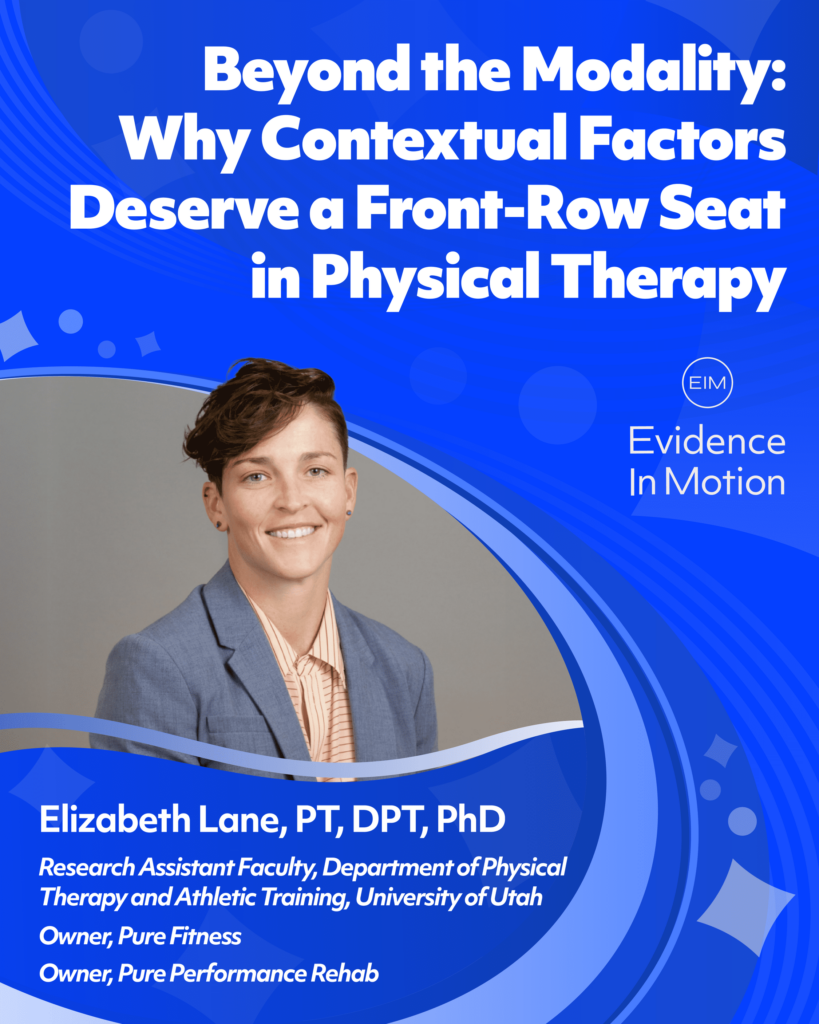
In physical therapy, we’ve traditionally been trained to chase specificity: targeted interventions, precise manual techniques, personalized exercise prescriptions. But what if a substantial portion of our patients’ improvements had little to do with the intervention itself?
Research continues to challenge the notion that physical therapy outcomes are solely the result of biomechanical forces or isolated protocols. Increasingly, we are learning that contextual factors (CFs) — the seemingly intangible aspects of the clinical encounter — may have neurobiological and psychological power that rivals the intervention itself. Could this really be true?!
🧠 What Are Contextual Factors?
Contextual factors refer to the non-specific, yet biologically meaningful components of care that surround the treatment:
- Therapist–patient relationship
- Expectations, beliefs, and prior experiences
- Language, communication style, and tone
- Treatment rituals and visual cues
- Clinic environment and setting
Historically labeled as “placebo” effects, CFs are now recognized as active contributors to outcomes, capable of inducing neurophysiological responses like endogenous opioid release, HPA-axis modulation, and altered cortical pain processing.
📚 What the Evidence Tells Us
- Most of the “Effect” May Be Contextual
A meta-analysis by Ezzatvar et al. (2024) found that up to 88% of the effect from common PT interventions like manual therapy, dry needling, and soft tissue work may be attributed to non-specific/contextual effects, not the intervention itself. Even exercise — widely accepted as a gold-standard treatment — showed ~46% of its pain-modulating effect as non-specific. Check out this publication to see exactly what % of your favorite treatment is attributable to contextual effects
Let’s take one of our collective favorites and look at the proportion of treatment effect not attributable to specific effects: Manipulation. Ah, those pops are so satisfying!
- 71% immediate pain
- 81% short-term pain
- 81% long-term pain
- 40% disability
- Language Alters Physiology
A 2019 RCT by Malfliet et al. showed that verbal expectations alone — positive, neutral, or negative — significantly influenced pain intensity, disability, and even salivary cortisol levels in people with chronic neck pain. Those receiving positive framing experienced greater improvements; negative framing even blunted the benefits of otherwise effective interventions.
- Perceived Mechanism Changes Perception
Louw et al. tested ultrasound applied in a clockwise vs. counterclockwise motion — patients who believed one direction was more effective actually had better outcomes in that direction. Despite being a meaningless mechanical difference, the perceived rationale mattered. This illustrates the power of patient belief and meaning to shape outcomes. (Louw 2016)
- Expectancy Changes Strength
In a fascinating sports psychology study (Maganaris, 2000), participants who believed they had been given steroids (but hadn’t) improved significantly more in strength training than controls — despite no pharmacologic difference. The takeaway? The brain’s expectation of enhanced performance can create real physiologic changes, including improved adaptation to load.
🧪 Clinical Example: Chronic Low Back Pain
Two patients with nonspecific low back pain are treated using graded exercise.
- Patient A is told: “We’ll try this for a few weeks and see what happens. Sometimes these don’t improve quickly.”
- Patient B hears: “This next phase is all about gradually loading the tendon and reintroducing movement. Your shoulder is strong and responding well — we’ll work as a team to keep progressing.”
Same program, different contextual frame. Guess who’s more likely to trust the process, adhere to rehab, and report progress?
💬 Example Language That Leverages CFs
| Purpose | Effective Language | ||
| Build expectation | “This approach has helped many people with similar symptoms.”; “Here’s exactly what you can expect over the next couple of visits…” | ||
| Validate experience | “What you’re describing makes sense given your history.”; “It makes sense you’re feeling frustrated — it’s tough.” | ||
| Reinforce alliance | “Let’s track your progress together and adjust if needed.”; “We will continue to monitor that pain you get when reaching to grab your seatbelt.” | ||
| Normalize discomfort | “Some muscle soreness is expected as you adapt — that’s progress.” | ||
| Empower autonomy | “Your body is resilient — we’re just helping it along.”;
|
🧠 Biological Mechanisms Behind CFs
- Opioid release: Positive expectations and supportive environments activate endogenous pain-relieving systems.
- HPA axis changes: As shown by cortisol level changes in Malfliet et al. (2019), expectations modulate stress hormone response.
- Conditioned learning: Ritualized treatments can reinforce associative learning that influences future outcomes.
- Nocebo effects: Negative framing, ambiguous explanations, or dismissive interactions can increase pain, stress, and perceived disability.
These aren’t abstract psychological effects — they’re real, measurable, and modifiable.
💡 Teaching or Team Discussion Starters
- How often do you explicitly shape patient expectations during evaluation or treatment?
- How might your tone or language unintentionally trigger a nocebo effect?
- Do you teach students or new clinicians how to use CFs ethically and effectively?
- Can two therapists using the same protocol get different outcomes based solely on delivery?
- How might we train for CFs the same way we train for technical skill?
🔑 Key Takeaways
- Contextual factors are not just “nice extras.” They are biological levers we can pull to enhance outcomes.
- Your delivery matters a lot. How much? Time will tell.
- Every clinical encounter is an opportunity to modulate pain, belief, and healing.
- Treat the relationship, the ritual, and the rationale — not just the rotator cuff.
📚 References
- Ezzatvar Y, Dueñas L, Balasch-Bernat M, Lluch-Girbés E, Rossettini G. Which portion of physiotherapy treatments’ effect is not attributable to the specific effects in people with musculoskeletal pain? J Orthop Sports Phys Ther. 2024;54(6):391–399. https://doi.org/10.2519/jospt.2024.12126
- Rossettini G, Palese A, Cook C. Trying to explain the unexplainable: why research on contextual factors in musculoskeletal pain is needed. Pain Manag. 2024;14(9):465–468.
- Malfliet A, et al. The influence of treatment expectations on clinical outcomes and cortisol levels in patients with chronic neck pain. Pain Pract. 2019;19(4):370–381.
- Louw A, Zimney K, Landers MR, Luttrell M, Clair B, Mills J. A randomised controlled trial of’clockwise’ultrasound for low back pain. South African Journal of Physiotherapy. 2016 Jan 1;72(1):1-7.
- Maganaris CN, et al. Expectancy effects and strength training: Do steroids make a difference? Sport Psychol.2000;14(2):144–156.
